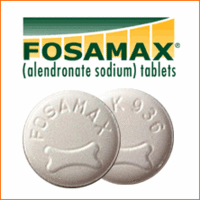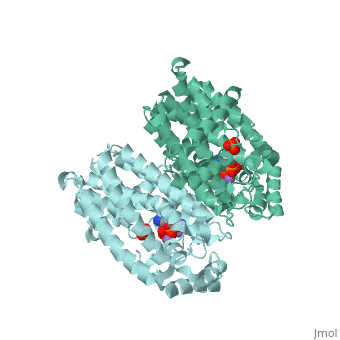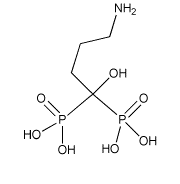Fosamax (alendronate sodium)
From Proteopedia
| Formula: | C4H13NO7P2 |
| Molar Mass: | 249.097 g/mol |
| INN: | Alendrotnic Acid |
| USAN: | Alendronate sodium |
| IUPAC: | 4-amino-1-hydroxybutylidene) bisphosphonic acid monosodium salt trihydrate |
Fosamax (Alendronate Sodium or Alendronic Acid) is a pharmaceutical drug administered to prevent and treat osteodegenerative diseases such as Osteoporosis. Functioning as a nitrogen-containing, second generation bisphosphonate, Fosamax binds to hydroxyapatite in bone and promotes apoptosis in osteoclasts (cells specialized in skeletal breakdown), thereby delaying the degradation of bone tissue. While incorporated in bone matrix, alendronate is not pharmacologically active, thus, it must be continuously administered to suppress osteoclasts on newly formed resorption surfaces [1].
Contents |
Structural Highlights [2]
| |||||||||||
Function
Functioning as a nitrogen-containing, second generation bisphosphonate, Fosamax binds to hydroxyapatite in bone and promotes apoptosis in osteoclasts (cells specialized in skeletal breakdown), thereby slowing the degradation of bone tissue[3]. Furthermore, alendronic acid binds to and inhibits the activity of farnesyl pyrophosphate synthase, an enzyme catalyzes a step in a biochemical pathway essential for homeostatic regulation of osteoclastic activity.
Mechanism
Fosamax inhibits farnesyl pyrophosphate synthase (FPS or FPPS), one of the enzymes found in the mevalonic acid pathway, which produces isoprenoid compounds that are essential for post-translational modification of small guanosine triphosphate (GTP)-binding proteins, such as Rho, Ras, and Rab. Inhibition of this process interferes with osteoclast function and survival [4]. The net negative charge of alendronic acid is thought to bind to three aspartate residues while also forming electrostatic interactions with Magnesium cofactors, binding in competition with other aminobisphosphates such as pamidronate and risedronate. [5].
Side Effects [6]
• Common side effects of Fosamax include gas, constipation, heartburn, diarrhea, bloating, nausea, vomiting, stomach pain, joint pain or swelling, swelling in your hands or feet, dizziness, headache, eye pain, back pain, or weakness.
• Serious side effects of Fosamax include severe pain (joints, bone, muscle, jaw, back or heartburn), chest pain, difficulty swallowing, bloody stools, eye pain, skin blisters, and swelling of the face, tongue, or throat.
References
- ↑ https://www.drugs.com/fosamax.html
- ↑ http://www.ebi.ac.uk/pdbe/entry/pdb/2F89
- ↑ https://www.ncbi.nlm.nih.gov/pmc/articles/PMC2667901/
- ↑ http://www.drugbank.ca/drugs/DB00630#bond-15126
- ↑ http://www.pnas.org/content/96/1/133.full.pdf
- ↑ http://www.rxlist.com/fosamax-side-effects-drug-center.htm
Contributors and Editors
Floro, Alyssa Jewel D. Kidd, Justin M.



